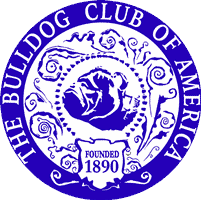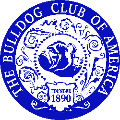The Bulldog Club of America Position Statement on
“A Genetic Assessment of the English Bulldog” (Pedersen, Pooch, & Liu, 2016)
Over the past few weeks, various media sources have published adverse articles on the Bulldog. These articles are based on the paper A Genetic Assessment of the English Bulldog released on July 29, 2016 in the journal Canine Genetics and Epidemiology (Pedersen, Pooch, & Liu, 2016). Dr. Pedersen, et al concluded “A DNA-based assessment of the breed along a number of parameters has confirmed that the breed is greatly lacking in genetic diversity, which may preclude or minimize the ability of breeders to recreate healthier phenotypes from existing genetic stock.”
The Bulldog Club of America (BCA) contends this study is neither a valid nor conclusive determinant of genetic diversity in the Bulldog.
Randomization and sample size in studies is critical to ensuring the validity of research. Reliable studies use random samples whenever possible, utilize appropriate sample sizes, avoid biases, and should be conducted by researchers who are not influenced by funding or the desire to seek certain results. In the case of Pedersen’s study, a small number of samples was used which most likely lacked wide representation. For this study the Veterinary Genetics Laboratory (VGL) at UC Davis provided DNA samples of 102 English Bulldogs; 87 of the dogs were from the USA and 15 were from other countries. The DNA samples, submitted for coat color testing, were considered the control group. The control group was then compared to an “unhealthy” group which consisted of samples from 37 dogs seen at UC Davis School of Veterinary Medicine for a variety of health problems.
The BCA does not believe the small number of samples used in Dr. Pedersen’s study represent the breed. The samples used were designated as “English Bulldog.” When submitting samples, UC Davis also has a designation for “Bulldog.” Members of the BCA have submitted health tests to UC Davis under the designation of “Bulldog” not “English Bulldog.” The greater numbers of dogs in the UC Davis data bank are designated as “Bulldog” not “English Bulldog.” However, the samples submitted for dogs designated as “Bulldogs” were not used in this study. These samples would have been more representative of breeders across the country.
Dr. Pedersen makes the statement, “Indeed, English Bulldog breeders appear to be more interested in adding recessive coat color mutation to increase puppy value than eliminating known deleterious mutations…” This statement is incorrect. BCA breeders do NOT condone the addition of recessive coat colors, and in fact, condemn the breeding of recessive coat colors. The BCA’s position was made clear on this point when its members changed its standard to disqualify all of these recessive coat colors.
The BCA is very concerned about health issues. A quick examination of the certifications on the OFA website reveals thousands of recorded certifications for the Bulldog. For example, in the last few years, there have been 1,684 cardiac certifications; 1,365 patella certifications; 583 tracheal hyposplasia certifications (this test has only been available since 2012); and 621 eye certifications. The number of actual certifications is much higher as not all breeders register certifications with OFA.
The Bulldog standard in the United States was first written in 1896. This standard does address the health of the dog. The standard requires the Bulldog to have “great stability, vigor and strength” of a certain size to prevent exaggerations. Another part of the standard states “no feature being in such prominence from either excess or lack of quality that the animal appears deformed or ill-proportioned.” Individual aspects of the dog are also addressed. For example, the eyelids “should show no ‘haw’”; the “nostrils should be wide, large and black;” the “legs should not be curved or bandy”; the “coat should be…smooth and glossy”; and the “gait should be unrestrained, free and vigorous.”
BCA is aware of breeders who promote non-standard colors as desirable and “exotic” and who are breeding for an extreme “Bulldog” which does not resemble the approved standard of excellence. One example of an extreme trait that seems to be highly prized in some of these commercial sites is an overly large nose wrinkle. The BCA condemns an overly large wrinkle which could constrict the air flow to the nostrils. These commercial breeders generally refer to the breed as “English Bulldogs” instead of the more proper designation in the United States as “Bulldog.” The breeders who are working to produce these undesirable colors are color testing their dogs so that they can produce with some certainty these “exotic” colors. In order to produce these undesirable, recessive colors, they must closely inbreed.
The members of BCA are NOT color testing. Consequently, the samples used for Dr. Pedersen’s study concern this group of breeders who are inbreeding for a more extreme dog not accepted in the standard. The paper indicates that this control group was “presumed to be of adequate health”. The BCA contends that this group should not be used as a control group because it is not representative of the Bulldog as a whole. Furthermore, we believe that this group carries health related problems in their pursuit for an exaggeration of the ideal Bulldog.
In 2002 Dr. Pedersen participated in a study similar to his current one. The study, Analysis of Genetic Variation in 28 Dog Breed Populations with 100 Microsatellite Markers (Irion, Schaffer, Famula, Eggleston, Hughes, and Pedersen, 2002) published in the Journal of Heredity, directly contradicts his present findings. In the 2016 paper, the authors state the Bulldog genome contains low genetic diversity. However, in the 2002 study Dr. Pederson demonstrates that the Bulldog genome contains an average amount of diversity when compared to 27 other breeds including the Labrador Retriever, the Border Collie, and the Bernese Mountain Dog. The Bulldog’s percent of alleles, average heterozygosity, and percent of loci in Hardy-Weinburg Equilibrium are all located within the mean of all breeds, and is not located at or near the low extreme. Therefore, the Bulldog genome contains average genetic diversity when compared to most other breeds, and is not considered low. This data corresponds well with the UK’s The Kennel Club’s data on inbreeding coefficients and effective population size, in which the Bulldog was found to be ranked 112th out of 215 breeds.
Lastly, the BCA questions the reliability of the paper’s resources. Many notations are not research based but are online sites, blogs and news articles. Much of the health and historical data of the Bulldog is referenced from the website http://www.bulldoginformation.com. This website is not a proper science reference due to its failure to cite references and the fact it is not current with the veterinary literature, and therefore contains many errors. There are several other key factual errors. We have listed a few:
- Dr. Pedersen states that the Bulldog is chrondrodysplastic. This is incorrect as shown by these studies discovering the genetic sources of canine chondrodysplasia: An Expressed FGF4 Retogene is Associated with Breed-Defining Chondrodysplasia in Domestic Dogs (Parker, 2009) and Canine Chondrodysplasia Caused by a Truncating Mutation in Collagen-Binding Integrin Alpha Subunit 10 (Kyostila, 2013). Both of these studies show the Bulldog genome to possess the normal variant of the gene and the breed does not have chondrodysplasia.
- Dr. Pedersen says that the Bulldog’s “lifespan estimates range from 3.2 to 11.3 years with a median of 8.4 years.” The most current resource is The Dog Breed Bible by D. Caroline Coile, PhD which lists the average lifespan of the English Bulldog in America as 8-12 years.
- Dr. Pedersen alludes to the Bulldog having been bred with the Pug relatively recently in the early 1900’s. This has been shown to be incorrect by multiple studies including the manuscripts Genomic Analysis of Modern Dog Breeds (Parker, 2012) and Breed Relationships Facilitate Fine-Mapping Studies: A 7.8-kh Deletion Cosegrates with Collie Eye Anomaly Across Multiple Dog Breeds (Parker, 2007). Both of these papers identify the Bulldog as a unique separate breed, most closely related to other bulldog-type breeds and the Mastiff.
- Dr. Pedersen says that physical changes in the Bulldog “have occurred over hundreds of years but have been particularly rapid over the last decades.” In fact, the Bulldog standard has virtually remained unchanged in the United States since 1896. The most substantial change to the standard occurred this year when BCA prohibited exotic coat and eye colors.
The BCA maintains that the Bulldog breed is popular because the breed is congenial with other dogs and cats, is congenial with children and adults, is content living in a house or apartment, is generally not a problem barker, is not a big shedder, and, if purchased from a reputable breeder, is healthy.
Our organization welcomes an outside scientific analysis of the Pedersen study.


